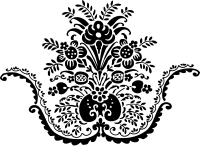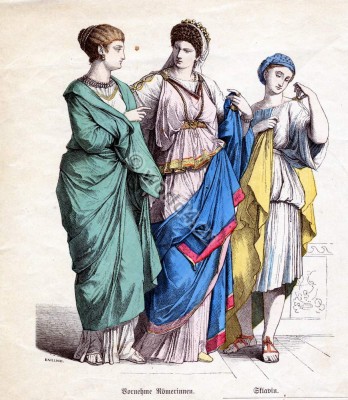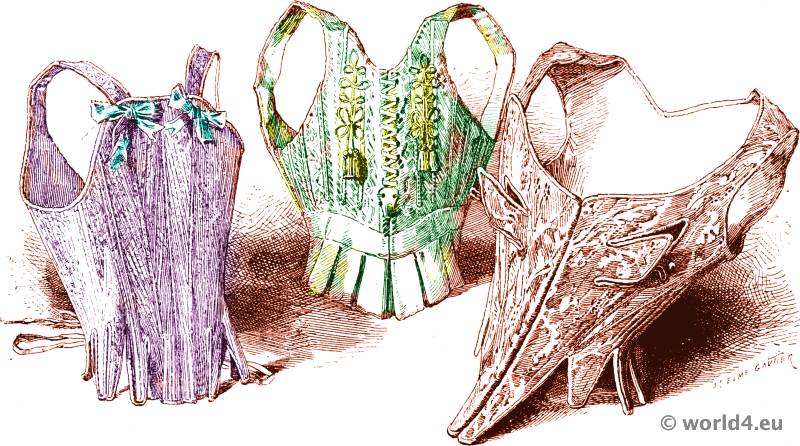CHAPTER II. Roman, Greece and Egypt.
Content:
Homer the first ethnic writer who speaks of an article of dress allied to the Corset – The cestus or girdle of Venus – Terentius, the Roman dramatist, and his remarks on the practice of tight-lacing – The use of the strophium by the ladies of Rome, and the mitra of the Grecian belles – The peplus as worn by the ancients – Toilet of a Roman lady of fashion – Roman baths – Fashionable promenades of Ancient Rome – Boundless luxury and extravagance – Cleopatra and her jewels – The taper waists and tightlacing of the ancient Roman ladies – Conquest of the Roman Empire.
The cestus or girdle of Venus
Amongst the ethnic writers, Homer appears to be the first who describes an article of female dress closely allied to the corset. He tells us of the cestus or girdle of venus, mother of the Loves and Graces, and of the haughty Juno, who was fabled to have borrowed it with a view to the heightening and increasing her personal attractions, in order that Jupiter might become a more tractable and orderly husband.
The poet attributes most potent magical virtues to the cestus, but these are doubtlessly used in a figurative sense, and Juno, in borrowing the cestus, merely obtained from a lady of acknowledged elegance of figure a corset with which to set her own attractions off to the best possible advantage, so that her husband might be charmed with her improved appearance; and Juno appears to have been a very far-seeing and sensible woman. From periods of very remote antiquity, and with the gradual increase of civilisation, much attention appears to have been paid to the formation and cultivation of the female figure, and much the same means were had recourse to for the achievement of the same end prior to 560 B.C. as in the year 1868.
Terentius, the Roman dramatist, and his remarks on the practice of tight-lacing
Terentius, the Roman dramatist, who was born in the year 560, causes one of his characters, in speaking of the object of his affections, to exclaim:
“This pretty creature isn’t at all like our town ladies, whose mothers saddle their backs and straitlace their waists to make them well-shaped. If any chance to grow a little plumper than the rest, they presently cry, ‘She’s an hostess,’ and then her allowance must be shortened, and though she be naturally fat and lusty, yet by her dieting she is made as slender as a broomstick. By this means one woodcock or another is caught in their springe.”
The use of the strophium by the ladies of Rome
Strutt informs us that the Roman women, married as well as unmarried, used girdles, and besides them they sometimes wore a broad swath or bandage round their breasts, called strophium, which seems to have answered the purpose of the bodice or stays, and had a buckle or bandage on the left shoulder, and that the mitra or girdle of the Greeks probably resembled the strophium of the Romans.
The annexed illustration represents a lady of Ancient Greece. He also speaks of the Muses as being described by Hesiod as being girt with golden “mitres,” and goes on to inform us that Theocritus in one of his pastorals introduces a damsel complaining to a shepherd of his rudeness, saying he had loosened her mitra or girdle, and tells her he means to dedicate the same to Venus. So it will be seen that the waist and its adornment were considered at that early period of the world’s history matters of no ordinary importance, and whether the term strophium, zone, mitra, custula, stays, bodice, or corset is made use of, the end sought to be obtained by their aid was the same.
The peplus as worn by the ancients
Constant mention is made by early writers of the peplus as being a very elegant garment, and there are notices of it as far back as the Trojan war, and the ladies of Troy appear to have generally worn it. On the authority of Strutt, it may be stated to have been “a thin light mantle worn by Grecian ladies above the tunic;” and we read that Antinous presented to Penelope a beautiful large and variegated peplus, having twelve buckles of gold, with tongues neatly curved. The peplus, however, was a very splendid part of the lady’s dress, and it is rarely mentioned by Homer without some epithet to distinguish it as such. He calls it the variegated peplus and the painted peplus, alluding to ornamental decorations either interwoven or worked with the needle upon it, which consisted not only in diversity of colors, but of flowers, foliage, and other kinds of imagery, and sometimes he styles it the soft purple peplus, which was then valuable on account of the excellence of the color.
Toilet of a Roman lady of fashion
We learn from a variety of sources that the early Roman and Grecian ladies indulged in almost unprecedented luxury in matters of personal adornment, as the following extract from Fullam will show: “The toilet of a Roman lady involved an elaborate and very costly process. It commenced at night, when the face, supposed to have been tarnished by exposure, was overlaid with a poultice, composed of boiled or moistened flour spread on with the fingers. Poppœan unguents sealed the lips, and the body was profusely rubbed with Cerona ointment. In the morning the poultice and unguents were washed off; a bath of asses’ milk imparted a delicate whiteness to the skin, and the pale face was freshened and revived with enamel.
The full eyelids, which the Roman lady still knows so well how to use-now suddenly raising them, to reveal a glance of surprise or of melting tenderness, now letting them drop like a veil over the lustrous eyes-the full, rounded eyelids were colored within, and a needle dipped in jetty dye gave length and sphericity to the eyebrows. The forehead was encircled by a wreath or fillet fastened in the luxuriant hair which rose in front in a pyramidal pile formed of successive ranges of curls, and giving the appearance of more than ordinary height.
'So high she builds her head, she seems to be,
View her in front, a tall Andromache;
But walk all round her, and you'll quickly find
She's not so great a personage behind.' "
“Roman ladies frequented the public baths, and it was not unusual for dames of the highest rank to resort to these lavatories in the dead hour of the night. Seated in a palanquin or sedan borne by sturdy chairmen, and preceded by slaves bearing flambeaux, they made their way through the deserted streets, delighted to arouse and alarm their neighbours.
A close chair conveyed the patrician matron to the spectacles and shows, to which she always repaired in great state, surrounded by her servants and slaves, the dependants of her husband, and the clients of her house, all wearing the badge of the particular faction she espoused. The factions of the circus were four in number, and were distinguished by their respective colors of blue, green, white, and red, to which Domitian, who was a zealous patron of the Circensian games, added the less popular hues of gold and purple.
But the spectators generally attached themselves either to the blue or the green, and the latter was the chief favourite, numbering among its adherents emperors and empresses, senators, knights, and noble dames, as well as the great mass of the people, who, when their champions were defeated, carried their partisanship to such an extreme that the streets were repeatedly deluged with the blood of the blues, and more than once the safety of the state was imperilled by these disgraceful commotions.
Fashionable promenades of Ancient Rome
“The public walks and gardens were a fashionable resort of the Roman ladies. There they presented themselves in rich costume, which bore testimony alike to the wealth of their husbands and their own taste. A yellow tire or hood partly covered, but did not conceal, their piled hair; their vest of muslin or sarcenet, clasped with gems, was draped with a murry-coloured robe descending to their high-heeled Greek boots; necklaces of emerald hung from their swan-like necks, and jewelled earrings from their ears; diamonds glittered on their fingers, and their dazzling complexions were shielded from the sun by a parasol.”
The researches of Strutt show us that the shoes of the ladies, and especially among the Romans, proved a very expensive part of the dress. In general they were white, but persons of opulence did not confine themselves to any color. We find them black, scarlet, purple, yellow, and green.
They were often not only richly adorned with fringes and embroideries of gold, but set with pearls and precious stones of the most costly kind, and these extravagances were not confined to persons of rank. They were imitated by those of lower station, and became so prevalent at the commencement of the third century, that even the luxurious Emperor Elagabalus thought it necessary to publish an edict prohibiting the use of such expensive shoes excepting to women of quality.
The women wore the close shoe or calceus. Gloves, too, as we have seen before, were known and used in very early ages, and it appears probable that they were first devised by those whose labours called them to the thick tangled thorn coverts, but that they were worn by those who did not labour is clearly proved by Homer, who describes the father of Ulysses when living in a state of rest as wearing gloves; but he gives us no information as to the material from which they were manufactured.
The Romans appear to have been much more addicted to the practice of wearing gloves than the Greeks, and we are informed that “under the emperors they were made with fringes,” though others were without them, and were fashioned much after the manner of the mittens of the present day.
Further on we learn that “as riches and luxury increased, the lady’s toilet was proportionately filled with ornaments for the person, so that it was called ’the woman’s world.’” They not only anointed the hair and used rich perfumes, but sometimes they painted it. They also made it appear of a bright yellow color by the assistance of washes and compositions made for that purpose; but they never used powder, which is a much later invention.
They frizzled and curled the hair with hot irons, and sometimes they raised it to a great height by rows of curls one above another in the form of a helmet, and such as had not sufficient hair of their own used false hair to complete the lofty pile, and these curls appear to have been fashioned with hairpins.
The Grecian virgins used to braid their hair in a multiplicity of knots, but that custom, as well as painting the under part of the eyelids with black paint, was discommended by an ancient poet. Persons of rank had slaves to perform for them the offices of the toilet. They held the mirror in their hand themselves and gave directions, and Martial tells us that, if the slaves unfortunately placed a hairpin wrong, or omitted to twist the curls exactly as they were ordered, the mirror was thrown at the offender’s head, or, according to Juvenal, the whip was applied with much severity.
The hair was adorned with ornaments of gold, with pearls and precious stones, and sometimes with garlands or chaplets of flowers. It was also bound with fillets and ribbons of various colors and kinds. The net or hair-caul for the purpose of inclosing the hinder part of the hair was in general use with the Grecian and Roman ladies. These ornaments were frequently enriched with embroidery, and sometimes made so thin that Martial sarcastically called them “bladders.“
Again, in the matter of earrings, we quote from the same valuable and trustworthy authority. No adornment of the head claims priority to earrings. They have been fashionable, as Montfaucon justly observes, in all ages and almost all nations. It is evident from Homer that the Grecian women bored their ears for the admission of these ornaments.
The poet gives earrings to the goddess Juno, and the words he uses on the occasion are literally these: “In her well-perforated ears she put the earrings of elaborate workmanship, having three eyes in each” – that is, three pendants or jewels, either made in the form of eyes, or so called from their brightness.
The extravagance of the Grecian and Roman ladies in the purchase of these articles of adornment almost exceeds belief. Pliny says, “They seek for pearls at the bottom of the Red Sea, and search the bowels of the earth for emeralds to ornament their ears;” and Seneca tells us that “a single pair of earrings was worth the revenue of a large estate, and that some women would wear at their ears the price of two or three patrimonies (A right or estate inherited from one’s father; or, in a larger sense, from any ancestor.).”
We read that the earrings worn by Cleopatra were valued at £161,458 (In today’s money about 1.400.000 British pounds) , and that Servilia, the mother of Brutus, was presented with a pair by Julius Caesar, the value of which was £48,457 (In today’s money about 400.000 British pounds).
Conquest of the Roman Empire
Bracelets are also ornaments of high antiquity, as are rings and brooches of various forms for fastening the dress. Rich gold chains and jeweled fastenings were in common use during this period.
The annexed illustration represents a Roman lady of rank about the reign of Elagabalus (Marcus Aurelius Antoninus Augustus, c. 203 – 222. Roman Emperor from 218 to 222. For the ancient and the modern posterity the name of Elagabalus became a symbol of vice and decadence of the Roman Empire was.).
Little alteration appears to have taken place in the general style of costume for some very considerable period of time, and the patrician ladies concealed beneath their flowing draperies a kind of corset, which they tightened very considerably, for a slight and tapering waist was looked upon as a great beauty in women, and great attention was paid to the formation of the figure, in spite of all that has been written about the purely natural and statuesque forms of the Roman matrons.
On the conquest of the Roman Empire by the wild and savage Hunnish tribes, fashion, art, taste, literature, and civilisation were swept ruthlessly away, and a long, weird night of mental darkness may be said to have reigned throughout the land from the tenth to the middle of the fifteenth century, and we see little or nothing of Roman elegance or magnificence of dress to distinguish it above other nations from that period.
Source: The Corset and the Crinoline. A Book of Modes and Costumes from remote Periods to the Present Time by W. B. L. (William Berry Lord). With 54 Full-Page and other Engravings. London: Ward, Lock, and Tyler. Warwick House, Paternoster Row. 1868.

Discover more from World4 Costume Culture History
Subscribe to get the latest posts sent to your email.







